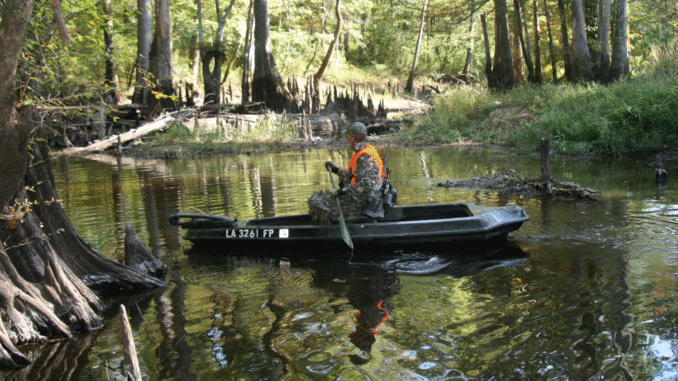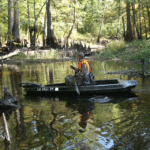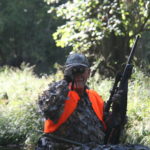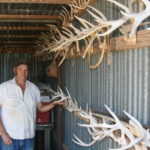
If you want to come in under a big buck’s radar, try slipping up on him in a pirogue.
I had spent all morning in my chest waders quietly wading through the backwater on my Winn Parish deer lease. When Dugdemona River comes up and floods the bottom, the deer become concentrated on the high ridges and move along the narrow natural levees that border the sloughs.
Stalking through the water has always been my favorite way to hunt, and on this particular day I was deep in a thicket we call the “Palmetto.” I had shot a large spike earlier, and was attempting to track him through the labyrinth of sloughs. When I stopped to ponder which way my deer might have gone, something caught my eye. It was someone’s head poking up above the slough bank.
I eased over and found Jim Dunegan, one of my fellow lease members, sitting in a small pirogue watching the woods. He had put his boat in at one of Dudgemona’s landings before daylight and had spent the morning paddling and drifting along the sloughs. After a short conversation, Dunegan drifted away to make his way back to his truck, and I was left there dreading the long, tiring wade ahead of me.
That chance encounter eventually made a big impact on my deer hunting. I continue to wade the backwater, but the older I got the harder it became. Over the years, I frequently thought of Dunegan sitting in his little pirogue and how much easier that would be than slogging through waist-deep water tripping on the unseen stumps and cypress knees. Finally, I bit the bullet and bought a fiberglass pirogue with a bow-mounted trolling motor.
My deer hunting has never been the same.
One of the things I enjoy most hunting from my boat is the comfort it provides. I have a nice elevated swivel seat that I can stay in for hours and plenty of room to carry a floating waterproof hunting bag that contains my camera, Thermos, water, snacks, matches and dry clothes. On many occasions when it is bitterly cold, I have even taken along my propane camp heater to keep my toes warm. So equipped, I often stay on the water from before daylight to after dark.
Whether I’m out for the day or for just a few hours, I always carry a life preserver (and wear it if I’m going to be in swift water), my chest waders and my full leafy suit. The life vest is for safety, and the chest waders are so I can get out and drag the boat over logs and obstacles. The leafy suit breaks up my outline and makes it harder for a deer to make out what I am.
Another thing a pirogue offers the deer hunter is versatility. I use three different hunting tactics when out in my boat.
Most of the time, I silently drift with the current watching the bank downstream and out into the woods on both sides. Drifting is the only way Dunegan hunts from his pirogue.
“I just ease around the creek and sloughs and hardly ever stop,” he said.
One of his best bucks came later on the same day that he had a harrowing accident on Saline Bayou (see sidebar). Not long after he dried out and resumed his drift, Dunegan spotted something in a nearby glade.
“It was a big buck, but when I fired he just ran off,” said Dunegan. “Dang, I thought, here I am soaking wet and freezing and I just missed a big buck to boot.
“But I always check after I shoot, so I went over to where it was standing and tracked it to a slough that had a pretty beach ridge on the other side. I hadn’t found any blood or anything, but I stood there thinking that ridge sure would be a good place to put a stand. Then something white caught my eye at the end of the ridge. I put my scope on it and it was the buck’s antlers shining in the sunlight. I bailed off into the slough to get to him and got soaked again.
“It was a huge 9-point, and he was so heavy I could hardly drag it, even in the water. I knew the pirogue wouldn’t carry both of us, so I hid him under some leaves and sticks and made it back to my truck. I then went home, got my aluminum boat and motor, and came back and got him.”
A good pair of binoculars is a must for drift hunting. Whenever I reach a straight stretch of water, I stop and carefully scan the banks ahead. Deer often will bed up against a tree right at the water’s edge, usually on the land side of the tree, and I look for a glint of antler or anything that seems out of place. More times than I can remember, I’ve been floating along only to have a deer explode from behind a tree not 10 feet from me. It always scares the bejeebers out of me.
Deer will also bed up on just about anything in flooded timber. Dunegan recalled one season when he tried unsuccessfully to bag a buck he kept seeing out in the water.
“There was a big oak tree that had fallen over with a big root ball at the base,” he said. “This buck would lay down on top of the root ball, and I tried to sneak up on him from every direction, but he always spotted me and took off through the water before I could get a shot.”
On a side note, I have discovered over the years that when I’m in my pirogue I don’t seem to spook deer nearly as much as I do when hunting on land. My theory is that they don’t sense much danger when they encounter people in boats because they’re used to seeing us fish. Plus, when I’m covered in my leafy suit, they don’t really realize that I’m a person at all.
One of my more memorable moments occurred two years ago when I was making my way through some small Dugdemona channels. Something caught my eye on an island not 30 yards away, but I couldn’t tell what it was. There was just something different about it from the countless other times I had passed that same spot.
Then I focused on what appeared to be a log. It was about the color of a deer, but I dismissed that thought because a deer would have run off before I got that close. When I finally reached down to get my rifle to scope it out, the “log’s” head shot up. And then another one popped up 6 feet away. Two does were bedded down on the little spit of ground. They had watched me come around the bend and get within pistol range without moving a muscle because they weren’t sure what I was. It wasn’t until I moved that they stood up and bounded off through the water.
When I do jump deer off the bank, I always scan the woods for awhile because they frequently will stop to look back at me. I first learned that on a float trip down Saline Bayou one early afternoon. Just as I passed a large cypress tree on my right, a deer jumped up and loped off into the woods. With my heart pounding, I slowly turned the boat around and there, just a few yards from where it had been bedded down, was a large spike standing broadside staring at me. I pulled the trigger and ended my hunt for the day.
Dunegan has developed his own technique for preventing a deer from running off after it spots him.
“I hear people say they can’t get close to deer in a boat or that they run off before they can get a shot,” he said. “One trick is not to make eye contact with them.
“When you see a deer but aren’t in a shooting position, look at him through the scope and then look away as you get nearer, look at him and then look away. Don’t ever stare at one. They know when you’re looking at them and if you stare at them they know they’ve been spotted. Just keep looking away and close the distance until you get within shooting range.”
A second pirogue tactic is to stop occasionally, sit quietly and watch the woods. This is a perfect way to hunt when the water is really high because you can sit in the pirogue and see over the bank and under the brush much farther out into the woods than if you were standing on the bank. During the rut, I also use my grunt call to try to lure in bucks that might be just out of sight.
And make sure to carry a small anchor or piece of rope so you can keep the boat in one place with your hands free to shoot. I’m still haunted by an opportunity I screwed up while hunting in the Palmetto one foggy morning. I put my pirogue into a small slough before daylight and floated down to an intersection where I planned to sit until it got good light.
The current was quite swift, so I grabbed a big vine to stop the boat. I had some rope but decided to just hold onto the vine and not tie up because I wasn’t going to stay long.
Then I began to hear something softly hitting the water at regular intervals. It sounded sort of like acorns dropping but I couldn’t be sure. Unfortunately, I’m hard of hearing and was unable to pinpoint where the noise was coming from.
Suddenly, a ghost-like apparition appeared out of the foggy drizzle. A nice 6-point was coming around the bend, calmly walking right toward me in the middle of the slough. In that nanosecond I realized I had made a big mistake by not tying up to a limb because if I let go of the vine to raise my rifle the boat would take off toward him, and he would be gone. When the buck was about 25 yards away, he stepped out onto the bank and suddenly realized I was there. We had a stare down that seemed to last forever until I finally decided to let go of the vine and grab the rifle. He was off in a flash, and I never even attempted the shot. After that, I’ve always made sure my hands are free when I sit to scan the woods.
A third pirogue tactic is to park occasionally and get out to hunt on land. You might pack a camp stool or climbing stand and spend the first few hours of daylight hunting in the woods or you might just get out occasionally to stretch your legs by stalking.
I did this on another foggy morning when I floated down the creek and stopped short of a ridge that always has a lot of scrapes and rubs. I crept up to within sight of the ridge but was still separated from it by a wide slough. The wind was in my favor and the rut was on, so I pulled out my deer call and gave three soft grunts. Nothing appeared, and I was just about to move closer when two wood ducks flushed out of the slough. Then out of nowhere, a nice 5-point walked out of a holly thicket and stepped into the water looking around for the rival buck. It was not until I got him loaded up and saw how low my little pirogue was riding that I realized I should have given more thought to carrying capacity.
No matter what tactic you use with your pirogue, always keep your ears open. Subtle sounds in the water will often give a deer away, such as my ghostly 6-point in the Palmetto.
“Always listen,” Dunegan advised. “I was in a flooded swamp one time, and kept hearing what sounded like water dripping. I’d go a little ways and then hear it again. Finally, I saw a whole bunch of deer — there must have been 10 or 15 of them — about belly deep in the water. They were ducking their heads under water to eat cow acorns off the bottom, and when they came up the water was dripping off their heads. I shot a big spike, and they took off in all directions.”
Pirogues are not just for fishing and duck hunting anymore. Try one out this deer season, and you might find yourself hooked on a whole new way to hunt.







